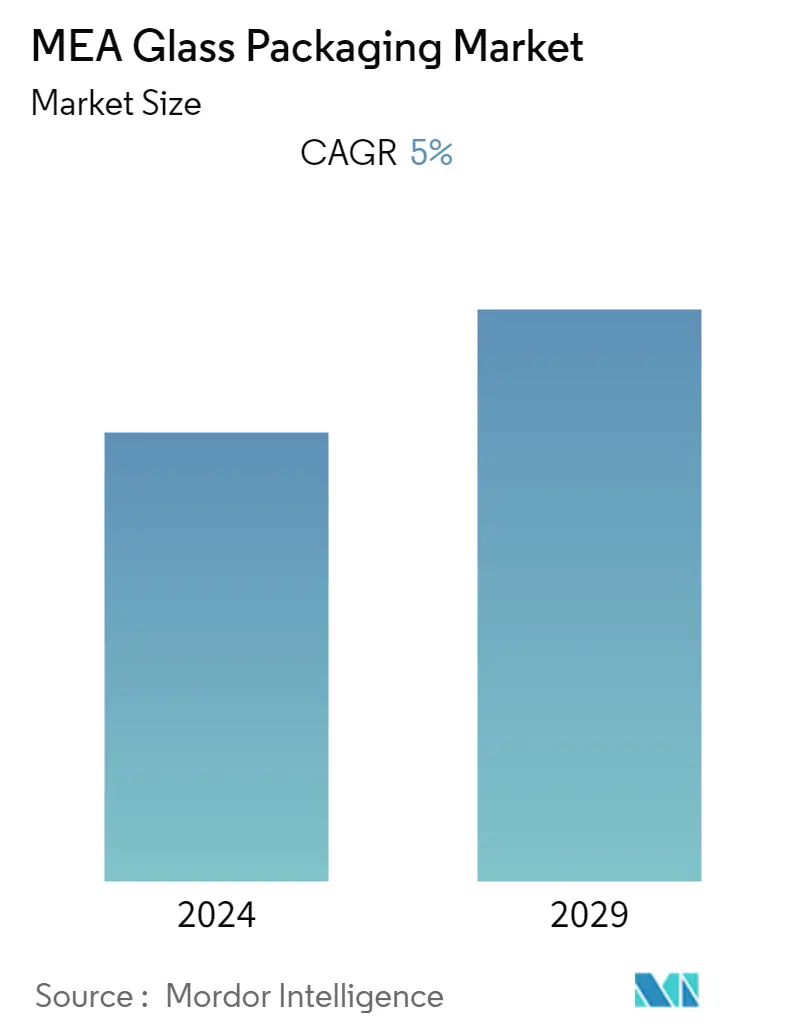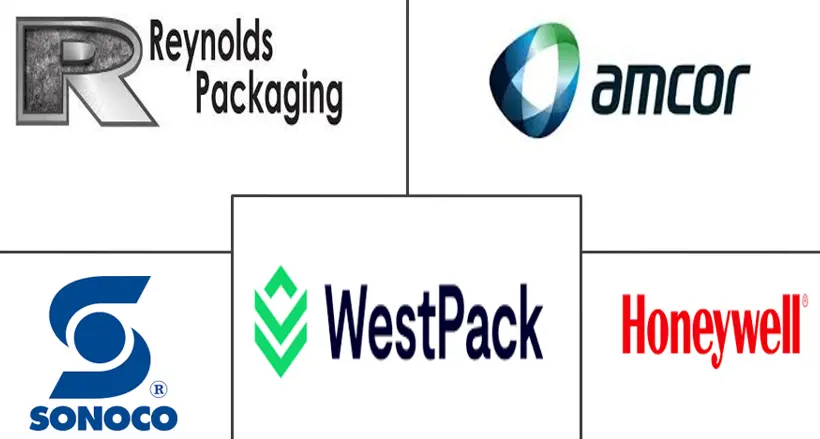Market Size of MEA Glass Packaging Industry

| Study Period | 2019 - 2029 |
| Base Year For Estimation | 2023 |
| Forecast Data Period | 2024 - 2029 |
| Historical Data Period | 2019 - 2022 |
| CAGR | 5.00 % |
| Market Concentration | Medium |
Major Players
*Disclaimer: Major Players sorted in no particular order |
MEA Glass Packaging Market Analysis
The Middle-East and African glass packaging market is expected to register a CAGR of 5% over the forecast period, 2021-2026. The impact of COVID-19 on glass had an indirect link as an essential business and was allowed to function.The Ethiopian glass container manufacturer, Addis Ababa Glass and Bottle Share Company, overlooks the capacity expansions. Amidst the COVID-19 pandemic, South Africa took stringent measures like halting all alcohol production.
- An increasing trend of transparency in food packaging over the past few years has been observed. This puts growing preference for glass as a material for packaging, being least opaque. Water is an emerging segment aligned with an increasing need for transparent glass containers with minimalist labeling. Multiple brands across the Middle Eastern region have depicted transitioning to glass to package water. For instance, in April 2021, Earth Water launched its natural mineral water lineup in glass bottles across the UAE. PepsiCo launched Aquafina water in Expo 2020 Dubai-cobranded as fully recyclable glass bottles to promote sustainable packaging.
- In March 2021, a new factory in Abu Dhabi planned to manufacture a COVID-19 vaccine from Chinese pharmaceutical giant Sinopharm under a joint venture between Sinopharm and Abu Dhabi-based technology company Group 42 (G42). The plant, built in the Khalifa Industrial Zone of Abu Dhabi (KIZAD), was planned to produce 200 million doses a year with three filling lines and five automated packaging lines. Similar expansion trends and investments are expected to demand glass packaging solutions in the regional pharmaceutical industry significantly.
- The policies against plastic for packaging are also creating new opportunities for the glass bottles and containers market. In February 2021, Kenya signed the Clean Seas Initiative and became one of the first countries in East Africa to limit single-use plastics. Also, as of June 2020, visitors to Kenya's national parks, beaches, forests, and conservation areas can no longer carry plastic water bottles, cups, disposable plates, cutlery, or straws into protected areas.
- According to International Finance Corporation (IFC), officials are considering promoting more local production from private pharma companies that produce generic medications and companies that manufacture active pharmaceutical ingredients or APIs (the primary components in manufacturing drugs). Ethiopia's National Strategy and Plan of Action for Pharmaceutical Manufacturing Development (2015-2025) also catalyzes pharmaceutical production at the country level.
MEA Glass Packaging Industry Segmentation
Glass is one of the most preferred packaging materials for consumers concerned about their health and the environment. It is made from all-natural sustainable raw materials. Glass packaging preserves the product's taste or flavor and maintains the integrity or healthiness of foods and beverages. The Middle-East and African glass packaging market is segmented by Products (Bottles, Jars, and Vials), End-user Industry (Pharmaceuticals, Medical, Personal care, Household care, and Agricultural), and Country.
| Products | |
| Bottles | |
| Jars | |
| Vials | |
| Other Products |
| End-user Industry | |
| Pharmaceuticals | |
| Medical | |
| Personal Care | |
| Household Care | |
| Agricultural |
| Country | |
| Saudi Arabia | |
| United Arab Emirates | |
| South Africa | |
| Rest of Middle-East and Africa |
MEA Glass Packaging Market Size Summary
The Middle-East and Africa glass packaging market is experiencing a steady growth trajectory, driven by increasing consumer preference for transparency in packaging and sustainability. The shift towards glass packaging is particularly notable in the food and beverage sectors, where brands are opting for glass to enhance product visibility and reduce environmental impact. The water segment, in particular, is witnessing a surge in demand for glass containers, with companies like Earth Water and PepsiCo leading the charge in promoting recyclable glass bottles. Additionally, the pharmaceutical industry is poised for growth in glass packaging solutions, fueled by expansions in local production and the need for secure and sustainable packaging options. The region's commitment to reducing plastic usage, as seen in initiatives like Kenya's Clean Seas Initiative, further bolsters the demand for glass packaging.
The glass packaging market in the Middle-East and Africa is moderately fragmented, with established players and new entrants vying for market share through innovation and strategic partnerships. The alcoholic beverage sector, while facing competition from metal packaging, continues to rely on glass for premium products, with local breweries and international retailers expanding their offerings. The presence of major pharmaceutical companies in the region presents opportunities for glass container manufacturers, as the demand for pharmaceutical glass packaging grows. Initiatives by companies like PepsiCo and local perfumeries in the UAE highlight the ongoing efforts to promote sustainable packaging solutions. Overall, the market is set to benefit from a combination of regulatory support, consumer trends, and strategic investments, positioning glass packaging as a key player in the region's packaging industry.
MEA Glass Packaging Market Size - Table of Contents
-
1. MARKET DYNAMICS
-
1.1 Market Overview
-
1.2 Market Drivers
-
1.2.1 High Opportunity for Middle-East and Africa Glass Bottles/Containers
-
-
1.3 Market Restraints
-
1.3.1 Decreased Alcohol Consumption
-
-
1.4 Industry Value Chain Analysis
-
1.5 Industry Attractiveness - Porter's Five Forces Analysis
-
1.5.1 Competitive Rivalry
-
1.5.2 Threat of New Entrants
-
1.5.3 Bargaining Power of Suppliers
-
1.5.4 Bargaining Power of Customers
-
1.5.5 Threat of Substitute Products
-
-
1.6 Industry Policies and Assessment of COVID-19 Impact
-
1.7 Technology Snapshot
-
-
2. MARKET SEGMENTATION
-
2.1 Products
-
2.1.1 Bottles
-
2.1.2 Jars
-
2.1.3 Vials
-
2.1.4 Other Products
-
-
2.2 End-user Industry
-
2.2.1 Pharmaceuticals
-
2.2.2 Medical
-
2.2.3 Personal Care
-
2.2.4 Household Care
-
2.2.5 Agricultural
-
-
2.3 Country
-
2.3.1 Saudi Arabia
-
2.3.2 United Arab Emirates
-
2.3.3 South Africa
-
2.3.4 Rest of Middle-East and Africa
-
-
MEA Glass Packaging Market Size FAQs
What is the current MEA Glass Packaging Market size?
The MEA Glass Packaging Market is projected to register a CAGR of 5% during the forecast period (2024-2029)
Who are the key players in MEA Glass Packaging Market?
Amcor Ltd., WestPack, Sonoco Products Company, Honeywell International, Inc. and Reynolds Packaging are the major companies operating in the MEA Glass Packaging Market.

